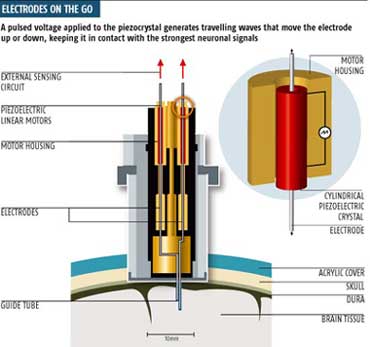December 12, 2004
Thought Control

With regularity, I'm finding articles on direct neural control of computers, more and more as time goes by. I remember when I encountered the first article, it was about a device that was installed on the surface of a Monkey's brain instead of into the tissue. Scientists drilled into the skull and deposited an M&M size device onto the surface of the brain. The monkey was able to control a computer cursor with the same dexterity as by hand.
What if we can control not just one cursor, but a whole keyboard?
Here's one of the recent ones:
With electrodes implanted directly on their brains, two Madison patients were able to control a computer cursor and play a basic video game just by thinking about it.
The accomplishment highlights an amazing new technology that in the last year has created the distinct possibility that severely disabled people may soon be able to communicate and even regain movement by tapping directly into the brain and training it to bypass damaged nerve cells.
"It's as if the first flight at Kitty Hawk has gone a few hundred feet," said Joseph Pancrazio, program director of neural engineering at the National Institute for Neurological Disorders and Stroke, part of the National Institutes of Health, which has funded the University of Wisconsin-Madison research and other projects.
The latest advance involves UW doctors who last month and in June removed a portion of the skulls of two patients and implanted electrodes on the surfaces of their brains.
Here's a very active method of neural implantation:
So far, implanted electrodes are unable to sense consistent neuronal signals for more than a few months.
Therefore, devices that automatically move electrodes through the brain to seek out the strongest signals will be essential tools if brain implants are ever going to work.
Joel Burdick and Richard Andersen at California Institute of Technology in Pasadena have developed the autonomous microdrive, a device in which the electrodes sense where the strongest signal is coming from, and move towards it. The prototype is mounted on the skull and uses piezoelectric motors to move four electrodes independently of each other....
The microdrive is still too bulky to be used for people and the team is working to make a smaller version with up to 100 electrodes so that within a year they expect to be able to fit a paralysed person with a microdrive implant that will allow them to control a computer cursor and navigate the web.
Autonomous microdrives could also eventually be used in other types of implant, such as the deep brain stimulators used to treat Parkinson?s disease.
Or course, this is probably the size of a toaster, but who can doubt that a nanotech solution won't shrink this tool down too the size of a... virus? (I was thinking of a mite, but why not go smaller?)
For those who don't want to sport the microdrive, here's a skullcap solution via Engadget:
"The results show that people can learn to use scalp-recorded electroencephalogram rhythms to control rapid and accurate movement of a cursor in two directions," said Jonathan Wolpaw and Dennis McFarlane.
The research team, from New York State Department of Health and State University of New York in Albany, said the research was another step towards people controlling wheelchairs or other electronic devices by thought.
I imagine a day when we can go down to the local Apple store and buy a next generation computer and the people at the "Genius Bar" will open an ampule of nanobots that will fly up my nose and install themselves into my cortext and retina.
And then what, Dennis?
Well, I will then be able to blog on the run!
Posted by Dennis at December 12, 2004 6:34 PM
Helo and regards from Finland. I read this site regularly and with big interest. Thanks.